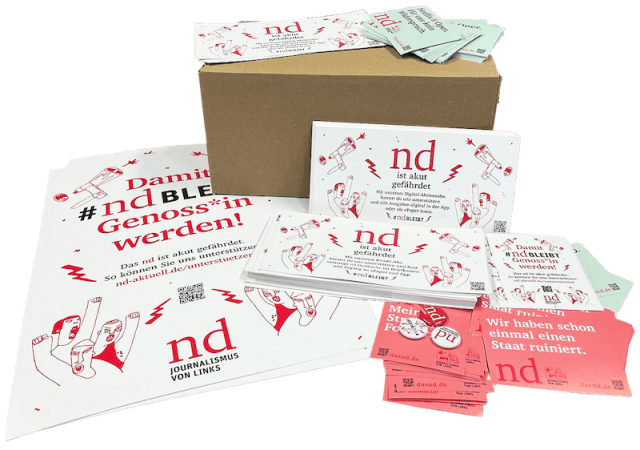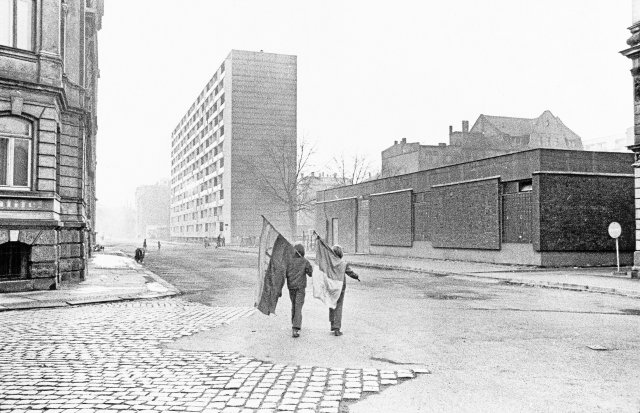Do you know these flags? Evelyn Richter, “Leipzig (Music District)”, 1976
Photo: Copyright Ostdeutsche Sparkassenstiftung
Sometimes criticism hurts a lot. For example, when an ideal that has been laboriously maintained is destroyed in one fell swoop. But sometimes it also uplifts. For example, if it exposes the critic more than you, who was the target of the criticism – and you suspect that you are on the right path.
The photographer Evelyn Richter, who died two years ago, could probably tell you a thing or two about it. “The fact that you photograph a person with a crooked nose is typical of your decadent attitude,” she once heard from a teacher at the University of Graphics and Book Arts (HGB) in Leipzig, where she had begun studying photography in 1953 . Crooked noses and decadence, in the fantastic world of socialist realism, that should only exist in the Federal Republic of Germany. A short time later, Richter was expelled from the university under arguments that today seem flimsy.
nd.Kompakt – our daily newsletter

Our daily newsletter nd.Compact brings order to the news madness. Every day you will receive an overview of the most exciting stories from the world editorial staff. Get your free subscription here.
The exhibition “Evelyn Richter. A Photographer’s Life” in the Leipzig Museum of Fine Arts (MdbK). The works on view here show Richter, who was born in 1930 to a middle-class family in Bautzen, as a multifaceted artist and accomplished theorist who mastered the craft of photojournalist as well as that of book illustrator.
It seems that it was her exmatriculation from the university and thus her exclusion from the state socialist mainstream that gave the photographer the necessary artistic freedom. From then on, Richter moved into niches as a freelancer and decided for herself which orders she would accept and which not. In the following years she worked for various theaters, the press, book publishers and well-known institutions such as the Gewandhaus or the Leipzig Trade Fair. Only when she was a nationally and internationally established and respected photographer was she retroactively awarded the state diploma by the HGB – almost 30 years after her exclusion.
The exhibition at the MdbK is divided into four parts: In the first part, Richter’s self-portraits are exhibited, which were mostly taken while traveling and in seemingly spontaneous moments – a touch of the social media age pervades the works, most of which were created well before the mass distribution of the Internet . This is followed in the second part by works from various photo books in which the artist was involved.
The third part of the exhibition is dedicated to her photojournalistic work, while the fourth part, under the simple title “Friends,” highlights the works of her close companions Eva Wagner-Zimmermann, Ursula Arnold and Christa Collector, with whom Richter was in close artistic exchange for many years. The aim of the show seems to be to document the interweaving of the artist with her private and professional environment in order to invalidate the still present idea of the (mostly male) brilliant individual artist – and this succeeds. The works on display here focus on artistic work based on social exchange.
Regardless of the specific context and origin, the works exhibited at the MdbK demonstrate Richter’s precise, unbiased view of their surroundings and great curiosity. Her wide-ranging work can best be assigned to the social documentary genre – and yet it would be too simplistic to say that Richter’s images follow a strict paradigm of realism. Her pictures are too aestheticized and sometimes composed for that, too characterized by staging and seemingly perfect photo moments. Her works therefore always oscillate between reality and staging, documentaryism and consciously evoked aesthetics. The longer you lose yourself in her pictures, the more the boundaries between the two poles seem to blur.
In many places, the exhibition links the works of the photographer, who died in 2021, with biographical cornerstones and information, without these becoming intrusive or obscuring the view of the photographs. Overall, the show bears witness to the inexhaustible drive of an artist whose works are still relevant today not despite, but precisely because of her indomitability.
»Evelyn Richter. A Photographer’s Life”, until March 17, 2024, Museum of Fine Arts Leipzig.
#ndstays – Get active and order a promotional package

Regardless of whether it is pubs, cafés, festivals or other meeting places – we want to become more visible and reach everyone who values independent journalism with an attitude. We have put together a campaign package with stickers, flyers, posters and buttons that you can use to get active and support your newspaper.
To the promotional package
sbobet judi bola online link sbobet judi bola online
